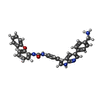Entry Database : PDB / ID : 3etaTitle Kinase domain of insulin receptor complexed with a pyrrolo pyridine inhibitor insulin receptor, kinase domain Keywords / / / / / / / / / / / / / / Function / homology Function Domain/homology Component
/ / / / / / / / / / / / / / / / / / / / / / / / / / / / / / / / / / / / / / / / / / / / / / / / / / / / / / / / / / / / / / / / / / / / / / / / / / / / / / / / / / / / / / / / / / / / / / / / / / / / / / / / / / / / / / / / / / / / / / / / / / / / / / / / / / / / Biological species Homo sapiens (human)Method / / / Resolution : 2.6 Å Authors Patnaik, S. / Stevens, K. / Gerding, R. / Deanda, F. / Shotwell, B. / Tang, J. / Hamajima, T. / Nakamura, H. / Leesnitzer, A. / Hassell, A. ...Patnaik, S. / Stevens, K. / Gerding, R. / Deanda, F. / Shotwell, B. / Tang, J. / Hamajima, T. / Nakamura, H. / Leesnitzer, A. / Hassell, A. / Shewchuk, L. / Kumar, R. / Lei, H. / Chamberlain, S. Journal : Bioorg.Med.Chem.Lett. / Year : 2009Title : Discovery of 3,5-disubstituted-1H-pyrrolo[2,3-b]pyridines as potent inhibitors of the insulin-like growth factor-1 receptor (IGF-1R) tyrosine kinase.Authors : Patnaik, S. / Stevens, K.L. / Gerding, R. / Deanda, F. / Shotwell, J.B. / Tang, J. / Hamajima, T. / Nakamura, H. / Leesnitzer, M.A. / Hassell, A.M. / Shewchuck, L.M. / Kumar, R. / Lei, H. / Chamberlain, S.D. History Deposition Oct 7, 2008 Deposition site / Processing site Revision 1.0 May 26, 2009 Provider / Type Revision 1.1 Jul 13, 2011 Group / Version format complianceRevision 1.2 Jul 24, 2019 Group / Refinement description / Category Item / _software.name / _software.versionRevision 1.3 Sep 6, 2023 Group / Database references / Refinement descriptionCategory chem_comp_atom / chem_comp_bond ... chem_comp_atom / chem_comp_bond / database_2 / pdbx_initial_refinement_model / struct_ref_seq_dif Item / _database_2.pdbx_database_accession / _struct_ref_seq_dif.details
Show all Show less
 Yorodumi
Yorodumi Open data
Open data Basic information
Basic information Components
Components Keywords
Keywords Function and homology information
Function and homology information Homo sapiens (human)
Homo sapiens (human) X-RAY DIFFRACTION /
X-RAY DIFFRACTION /  SYNCHROTRON /
SYNCHROTRON /  MOLECULAR REPLACEMENT / Resolution: 2.6 Å
MOLECULAR REPLACEMENT / Resolution: 2.6 Å  Authors
Authors Citation
Citation Journal: Bioorg.Med.Chem.Lett. / Year: 2009
Journal: Bioorg.Med.Chem.Lett. / Year: 2009 Structure visualization
Structure visualization Molmil
Molmil Jmol/JSmol
Jmol/JSmol Downloads & links
Downloads & links Download
Download 3eta.cif.gz
3eta.cif.gz PDBx/mmCIF format
PDBx/mmCIF format pdb3eta.ent.gz
pdb3eta.ent.gz PDB format
PDB format 3eta.json.gz
3eta.json.gz PDBx/mmJSON format
PDBx/mmJSON format Other downloads
Other downloads 3eta_validation.pdf.gz
3eta_validation.pdf.gz wwPDB validaton report
wwPDB validaton report 3eta_full_validation.pdf.gz
3eta_full_validation.pdf.gz 3eta_validation.xml.gz
3eta_validation.xml.gz 3eta_validation.cif.gz
3eta_validation.cif.gz https://data.pdbj.org/pub/pdb/validation_reports/et/3eta
https://data.pdbj.org/pub/pdb/validation_reports/et/3eta ftp://data.pdbj.org/pub/pdb/validation_reports/et/3eta
ftp://data.pdbj.org/pub/pdb/validation_reports/et/3eta
 Links
Links Assembly
Assembly
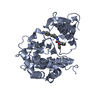
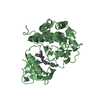
 Components
Components Homo sapiens (human) / Gene: INSR / Plasmid: pFastbac / Production host:
Homo sapiens (human) / Gene: INSR / Plasmid: pFastbac / Production host: 
 X-RAY DIFFRACTION / Number of used crystals: 1
X-RAY DIFFRACTION / Number of used crystals: 1  Sample preparation
Sample preparation SYNCHROTRON / Site:
SYNCHROTRON / Site:  APS
APS  / Beamline: 17-ID / Wavelength: 1 Å
/ Beamline: 17-ID / Wavelength: 1 Å Processing
Processing MOLECULAR REPLACEMENT
MOLECULAR REPLACEMENT Movie
Movie Controller
Controller


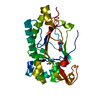
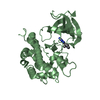


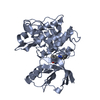

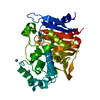


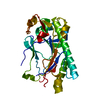
 PDBj
PDBj











